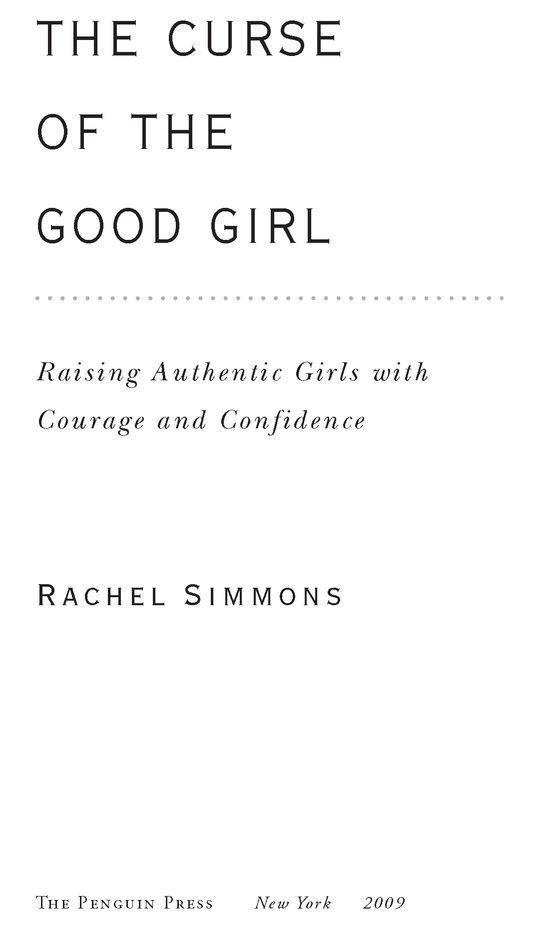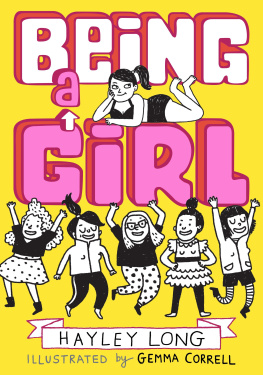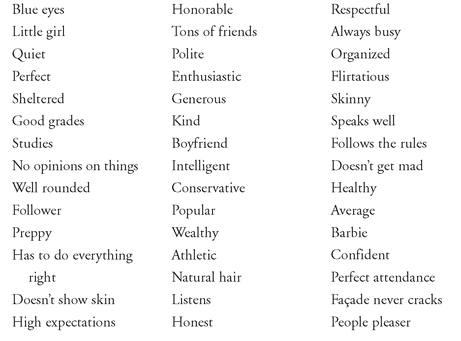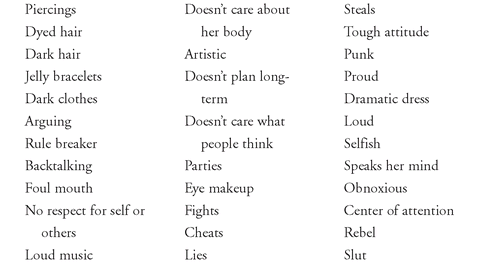Table of Contents
ALSO BY RACHEL SIMMONS
Odd Girl Out: The Hidden Culture of Aggression in Girls
Odd Girl Speaks Out: Girls Write About Bullies, Cliques,
Popularity, and Jealousy

THE PENGUIN PRESS
Published by the Penguin Group
Penguin Group (USA) Inc., 375 Hudson Street, New York, New York 10014, U.S.A.. Penguin Group
(Canada), 90 Eglinton Avenue East, Suite 700, Toronto, Ontario, Canada M4P 2Y3 (a division of Pearson Penguin
Canada Inc.) Penguin Books Ltd, 80 Strand, London WC2R 0RL, England Penguin Ireland, 25 St. Stephens
Green, Dublin 2, Ireland (a division of Penguin Books Ltd) . Penguin Books Australia Ltd, 250 Camberwell Road,
Camberwell, Victoria 3124, Australia (a division of Pearson Australia Group Pty Ltd) . Penguin Books India Pvt Ltd,
11 Community Centre, Panchsheel Park, New Delhi - 110 017, India . Penguin Group (NZ), 67 Apollo Drive,
Rosedale, North Shore 0632, New Zealand (a division of Pearson New Zealand Ltd) . Penguin Books
(South Africa) (Pty) Ltd, 24 Sturdee Avenue, Rosebank, Johannesburg 2196, South Africa
Penguin Books Ltd, Registered Offices:
80 Strand, London WC2R 0RL, England
First published in 2009 by The Penguin Press,
a member of Penguin Group (USA) Inc.
Copyright Rachel Simmons, 2009
All rights reserved
The author has changed the names and identifying details of interview subjects.
The ages of the girls have not been changed.
LIBRARY OF CONGRESS CATALOGING IN PUBLICATION DATA
Simmons, Rachel, date.
The curse of the good girl : raising authentic girls with courage and confidence / Rachel Simmons.
p. cm.
Includes bibliographical references and index.
eISBN : 978-1-101-13353-8
1. GirlsPsychology. 2. GirlsConduct of life. I. Title.
HQ777.S56 2009
155.433dc22 2009003566
Without limiting the rights under copyright reserved above, no part of this publication may be reproduced, stored in or introduced into a retrieval system, or transmitted, in any form or by any means (electronic, mechanical, photocopying, recording or otherwise), without the prior written permission of both the copyright owner and the above publisher of this book.
The scanning, uploading, and distribution of this book via the Internet or via any other means without the permission of the publisher is illegal and punishable by law. Please purchase only authorized electronic editions and do not participate in or encourage electronic piracy of copyrightable materials. Your support of the authors rights is appreciated.
http://us.penguingroup.com
For my brother
and
for the Girls Leadership Institute alumnae:
for teaching me, for trusting me
INTRODUCTION
Our culture is teaching girls to embrace a version of selfhood that sharply curtails their power and potential. In particular, the pressure to be Goodunerringly nice, polite, modest, and selflessdiminishes girls authenticity and personal authority.
The Curse of the Good Girl erects a psychological glass ceiling that begins its destructive sprawl in girlhood and extends across the female life span, stunting the growth of skills and habits essential to becoming a strong woman. This book traces the impact of the curse on girls development, and provides parents with the strategies to break its spell.
Almost ten years ago, I founded the Girls Leadership Institute, a summer enrichment program for middle- and high-school girls. I began asking largely middle-class groups of girls to describe how society expected a Good Girl to look and act. Here is a sample response:
The Good Girl was socially and academically successful, smart and driven, pretty and kind. But she was also an individual who aimed to please (people pleaser), toed the line (no opinions on things) and didnt take risks (follows the rules). She repressed what she really thought (doesnt get mad ) and did not handle her mistakes with humor (has to do everything right).
The Good Girl walked a treacherous line, balancing mixed messages about how far she should go and how strong she should be: she was to be enthusiastic while being quiet; smart with no opinions on things; intelligent but a follower; popular but quiet. She would be something, but not too much.
We live in the age of the fiercely successful amazing girl. Girls outnumber boys in college and graduate school. They graduate at higher rates. In high school, girls pursue more leadership roles and extracurricular activities than boys do, and they are significantly more likely to see themselves as leaders.
But if their college applications are stamped with twenty-first-century girl power, girls psychological rsums lag generations behind. The Curse of the Good Girl erodes girls ability to know, say, and manage a complete range of feelings. It urges girls to be perfect, giving them a troubled relationship to integrity and failure. It expects girls to be selfless, limiting the expression of their needs. It demands modesty, depriving girls of permission to commit to their strengths and goals. It diminishes assertive body language, quieting voices and weakening handshakes. It reaches across all areas of girls lives: in their interactions with boys and other girls, at school, at home, and in extracurricular life. The Curse of the Good Girl cuts to the core of authentic selfhood, demanding that girls curb the strongest feelings and desires that form the patchwork of a person.
The curse is the product of a culture that remains confused about gender equality. In Meeting at the Crossroads, Lyn Mikel Brown and Carol Gilligan documented a crisis of connection in girls approaching adolescence. Girls withheld their true thoughts and feelings in an attempt to maintain perfect relationships. Nearly twenty years later, little has changed. In a 2006 study by Girls, Inc., 74 percent of girls said they were under a lot of pressure to please everyone, a nearly nine-point increase from 2000. Nearly half the girls surveyed said that girls are told not to brag about the things they do well and that the smartest girls in my school are not popular. A majority said they were expected to speak softly and not cause trouble.
In a 2008 study by the Girl Scouts, girls aged eight to seventeen worried that leadership positions would make them seem bossy and lead to negative attention from peers.
Another study found girls significantly less likely than boys to want to be the boss or in charge of others.
Our cultures mixed feelings about girl power emerge most clearly in girls descriptions of Bad Girls:
The Bad Girl was the picture of female failure, a reckless rejection of femininity, everything a girl was told not to be. She was the odd girl out with a bad reputation, low to no status, and few friends.
Yet she was also independent and authentic. The Bad Girl was outspoken (speaks her mind ) and self-possessed (proud ), a risk taker (rule breaker) and critical thinker (artistic, rebel, doesnt care what people think). She was comfortable being in charge (center of attention). But she was nothing if not an outcast, an example to Good Girls of what happened when you strayed from the program. Being Bad was social suicide: a big, red F in Girl.














